Imagine this situation: you are hiking through the Andes in South America.
The view is breathtaking, the selfies look amazing, you can’t wait to get back to your hotel and post the pictures on Instagram.
Suddenly, you notice something moving in the distance. It looks like a llama, but you are not sure. Is it an alpaca? Maybe a wild guanaco? Did you even hear of a vicuna?
How could you know which animal is it?! It’s not that hard to distinguish one from the other.
There are several animals similar to llamas. These are alpacas, guanacos, and vicunas. Camels, sheep, and some camelid hybrids also resemble llamas. Most of these animals are related and are members of the same Camelidae family.
Around 17 million years ago Old World camelids (camels) and the New World camelids (llamas, vicunas, guanacos, alpacas) split from one another.
Here are the main descriptions and photos of these so you know the difference.

| Characteristics | Llama | Alpaca | Vicuna | Guanaco | D. Camel |
| Size | 3.8 ft (115 cm) | 3 ft (90 cm) | 3 ft (90 cm) | 3.7 ft (112 cm) | 7 ft (213 cm) |
| Weight | 308.6 lb (140 kg) | 154.3 lb (70 kg) | 99.2 lb (45 kg) | 200 lb (90 kg) | 1,600 lb (726kg) |
| Lifespan | 15 to 25 years | 15-20 years | 15-20 years | 12-16 years | 40 years |
| Color | Brown, black, white, or gray | Brown, black, white, or gray | Yellowish, light brown, white in front of the rear limbs and top of the back | Light to dark reddish-brown above, whitish hair below | Cream, yellow, brown |
| Fiber | 20-40 microns | 20-35 microns | 12-14 microns | 14-15 microns | 20 – 50 microns |
Table of Contents
Llama
Main information:
- Scientific Name: Lama Glama
- Common Name: Llama (fr. Lama; ger. Lama; es. Llama)
- Size: 3.8 ft (115 cm)
- Weight: 308.6 lb (140 kg)
- Lifespan: 15 to 25 years
- Diet: Herbivore
- Distribution: Bolivia, Peru, Argentina, Chile, Ecuador, Colombia
- Conservation Status: Not Extinct
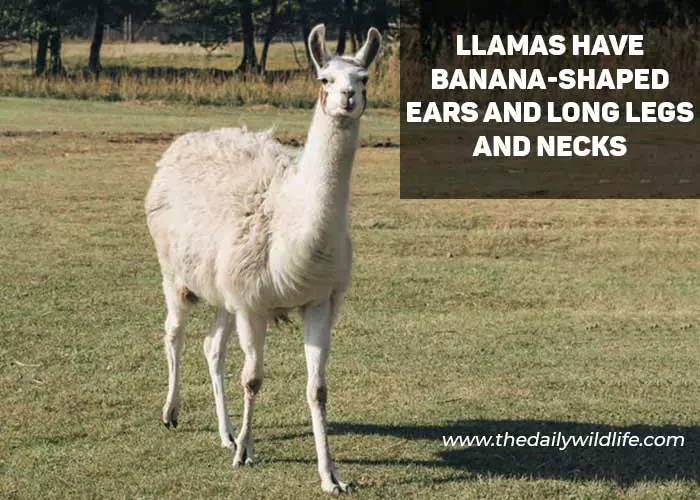
Llamas are domesticated animals that originated from the guanaco. Lamas live high in the Andes, in elevated grasslands known as the puna.
They can be found in Bolivia, Peru, Argentina, Chile, but also in Ecuador and Colombia, at heights ranging from 7,550 to 13,120 ft (2,300–4,000 m).
They have an average height of 3.8 ft (115 cm) and weigh 308.6 lb (140 kg).
Llamas have long legs and characteristically inwardly curved tips of their ears (banana ears).
They can have a brown, black, white, or gray wool color. Some llamas will have a combination of these colors, while others will have a piebald or speckled pattern.
Llama’s fiber is between 20 and 40 microns in diameter – this means that their wool is fine, soft, and silky.
People have been using llamas’ fleece to make clothes, ropes, bags; their skin to make leathery goods; their meat and milk as food. Llamas are important pack animals in the Andes.
Llamas and alpacas are very similar animals to one another and can be distinguished by their size, the length of their wool, the shape of their ears, and the position of their tails.
Llamas are bigger, have banana-shaped ears, and hold tails high in the air when walking.
Alpacas have longer fleece, spear-shaped ears, and do not raise their tails.
Alpaca
Main information:
- Scientific Name: Lama pacos
- Common Name: Alpaca (fr. Alpaga; ger. Alpaka; es. Alpaca)
- Size: 3 ft (90 cm)
- Weight: 154.3 lb (70 kg)
- Lifespan: 15-20 years
- Diet: Herbivore
- Distribution: Peru, Bolivia, Chile
- Conservation Status: Not Extinct

Just like the llama, alpaca is another domesticated South American camelid. Alpacas originated from the wild vicuna and live in Peru, Bolivia, and Chile, at elevations from 9,840 to 15,750 ft (3,000–4,800 m).
They can reach 3 ft (90 cm) in height and weigh 154.3 lb (70 kg).
Alpacas have a small head, short pointy ears, and a very long neck. Alpaca’s entire bodies are covered by long, thick, and soft wool. They have short legs and males can have a tuft on their head that covers the eyes.

Their fleece is from 20 to 35 microns in diameter – this means they have a softer fur than llamas.
The color of the alpaca’s fleece is similar to llama wool – it can range from black to brown, silver, rose gray, fawn, and white. People use alpacas primarily for their meat, soft wool, and their dung as fuel.
Alpacas are adorable, docile, and soft animals – people love keeping them as pets. They stand out from llamas because of their bushier and fluffier wool.
Vicuna
Main information:
- Scientific Name: Vicugna vicugna
- Common Name: Vicuna (fr. Vigogne; ger. Vikunja; es. Vicuña)
- Size: 3 ft (90 cm)
- Weight: 99.2 lb (45 kg)
- Lifespan: 15-20 years
- Diet: Herbivore
- Distribution: Peru, Bolivia, Chile, Argentina
- Conservation Status: Least Concern (Population increasing)

Vicunas are wild South American camelids that gave rise to alpacas. They live in the Andes, in Peru, Bolivia, Chile, and Argentina, at elevations 11,480–18,860 ft (3,500–5,750 m).
Vicunas are the national symbol of Peru; their coat of arms includes a vicuna.
They have an average height of 3 ft (90 cm) at the shoulder and weigh around 99.2 lb (45 kg).
Vicunas have a slender body, long neck, and a small head – their ears and eyes stand out. They have a long fur of the chest to protect the animal when laying on the ground. The neck, back parts, and sides have a light brown color.
Vicuna has one of the finest and most expensive wool in the world measuring between 12 and 14 microns. The wool helps to insulate the animal against the cold conditions and UV radiation experienced at high altitudes.
They are easy to distinguish from llamas and other camelids as they are the smallest of all of their relatives.
The vicuna’s heart is almost 50% larger than the average heart of a similar-sized mammal.
These alpaca’s wild relatives were on the verge of extinction in the 1960s and 1970s. In 1974, there were less than 6,000 vicunas in the wild.
Because of conservation measures, their population increased to around 340,000 in 2015.
Read more: How similar are vicunas and alpacas?
Guanaco
Main information:
- Scientific Name: Lama guanicoe
- Common Name: Guanaco (fr. Guanaco; ger. Guanako; es. Guanaco)
- Size: 3.7 ft (112 cm)
- Weight: 200 lb (90 kg)
- Lifespan: 12-16 years
- Diet: Herbivore
- Distribution: Argentina, Peru, Chile, Bolivia, Paraguay
- Conservation Status: Least Concern (Population stable)
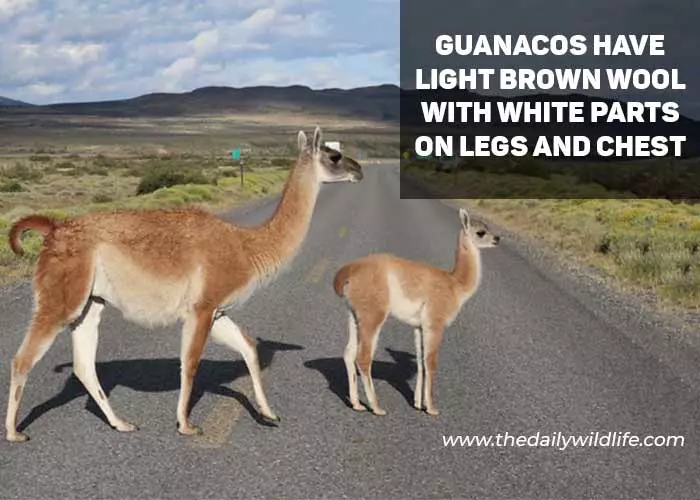
Guanacos are llamas’ wild ancestors, that’s why they look the most alike. They live in Argentina, the high Andes of Peru, Chile, and some parts of Bolivia and Paraguay. They inhabit grasslands and shrublands ranging from sea level to over 11,482 ft (3,500 m).
Guanacos have an average height of 3.7 ft (112 cm) and weigh around 200 lb (90 kg).
They have a slender body with relatively short wool. They have brown wool with white patches on the lips, ears, the lower part of the body, and the inner side of the legs. Their feet are brown and their faces have a slightly greyish color.
They are slightly larger than alpacas and a lot bigger larger than vicuñas. Compared to llamas, guanacos are smaller and less heavily built.
Guanacos rarely survive for more than twelve years; they die due to starvation, hunting, and skin diseases.
Guanaco also has fine wool that measures from 14 to 15 microns; only the vicuna has finer wool than it.
They are very social animals that live in herds that consist of a dominant male and females with their offspring. Guanaco babies are called chulengos and can walk 5 minutes after being born.
Read More: Differences between a llama and a guanaco
Bactrian Camel
Main information:
- Scientific Name: Camelus bactrianus
- Common Name: Bactrian camel (fr. Chameau; ger. Kamel; es. Camello)
- Size: 7 ft (213 cm) at the hump
- Weight: 1,100 lb (500 kg)
- Lifespan: 40 years
- Diet: Herbivore
- Distribution: Mongolia and China
- Conservation Status: Not Extinct (Wild Bactrian camels – Critically Endangered)
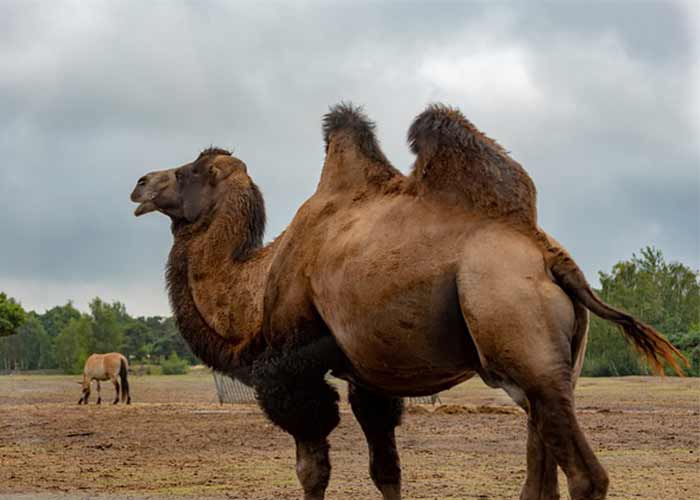
Bactrian camels are llamas’ distant cousins that have two humps. There are two species of Bactrian camels, the domesticated and wild ones.
Camels and llamas do not look the same but have some common characteristics: thick fur, long snout, split lips, long legs and necks, among others.
The Bactrian camel is a lot bigger than a llama and has an average height of 7 ft (213 cm) at the hump. They weigh about 1,100 lb (500 kg).
The wild Bactrian camel has a sandy, gray-brown coat while the domestic Bactrian has a dark brown one. Both Bactrians, as well as llamas, have very tough padded feet, which enable them to walk in different terrains.
Dromedary Camel
Main information:
- Scientific Name: Camelus dromedarius
- Common Name: Dromedary camel (fr. Dromedaire; ger. Dromedar; es. Dromedario)
- Size: 7 ft (213 cm) tall at the hump
- Weight: 1,600 lb (726kg)
- Lifespan: 40 years
- Diet: Herbivore
- Distribution: Middle East, India, Africa, Australia
- Conservation Status: Not Extinct
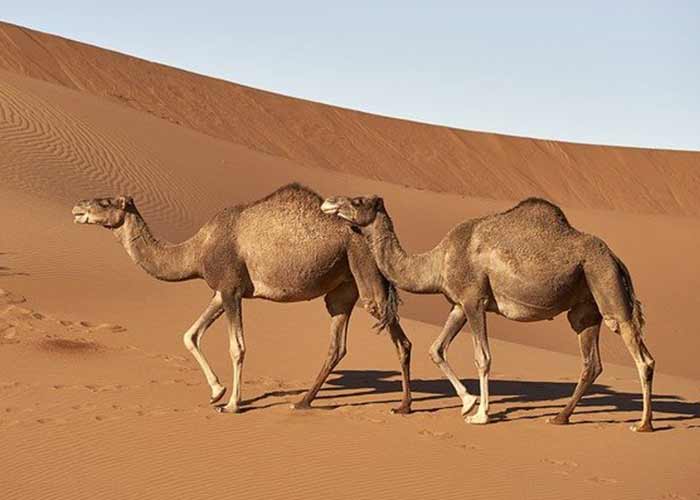
Dromedary camels are more similar to llamas than Bactrian camels are. They all have in common long necks, thin legs, and elongated snouts.
Dromedaries have one hump and are about 7 ft (213 cm) tall at the hump. They weigh around 1,600 lb (726 kg). This makes them significantly bigger and heavier than llamas and other camelids.
Sheep
Main information:
- Scientific Name: Ovis aries
- Common Name: Domesticated Sheep (fr. Mouton; ger. Schaf; es. Oveja)
- Size: 3 ft (91 cm) tall at the withers
- Weight: 220 lb (100 kg)
- Lifespan: 12 years
- Diet: Herbivore
- Distribution: Worldwide
- Conservation Status: Not Extinct
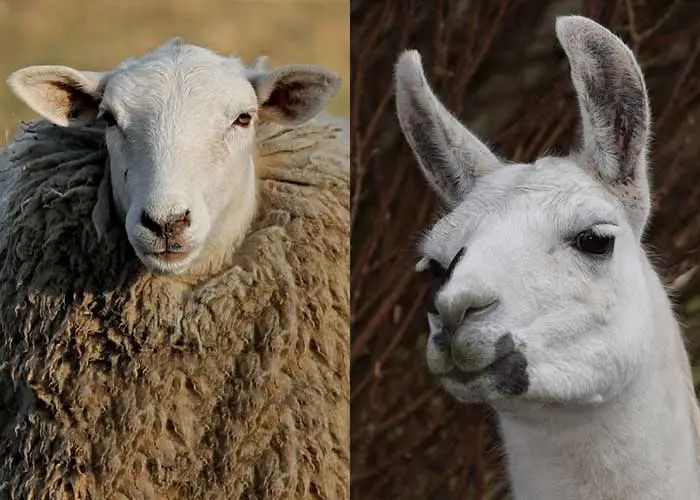
Sheep are not as similar to llamas as these previous animals are, but still resemble llamas a bit. Both have long snouts, prehensile lips, and wooly bodies. Sheep are herbivores and members of the order Artiodactyla, just like llamas are.
They are around 220 lbs heavy but can grow up to 350 lbs (160 kg). Llamas are taller than sheep and have longer legs and necks. Also, a big difference is the ear shape. Lambs resemble llama babies (crias) more than adult sheep resemble grown llamas.
Finally, several sheep species have horns; llamas do not have them.
Read more: Llamas Vs Sheep – are they related?
Camelid Hybrids
Llamas, alpacas, guanacos, and vicunas can all interbreed and produce fertile offspring.
The offspring of a male llama and a female alpaca is the huarizo. The offspring of a female llama and a male alpaca is called misti.
The paco-vicuna is the offspring of a male vicuna and a female alpaca while the llama-vicuna is the result of breeding a male vicuna and a female llama.
A llamo-guanaco or llanaco is the result of a male guanaco and a female llama interbreeding; the paco-guanaco is a result of breeding between a male alpaca with a female guanaco.
Camels can breed with llamas, but only with human intervention. The result is a hybrid called cama.
Read More: Guanaco and vicuna, similarities and differences
Final Thoughts
This concludes our article on animals similar to llamas. Here, we explained the main characteristics of all of these related animals: llamas, alpacas, guanacos, vicunas, and camels.
All of these animals are similar, but also different in size, weight, and fur color. Llamas are the biggest of all of their South American relatives, only smaller than camels. Alpacas can be distinguished by their fluffy wool and shorter snout than llamas.
Vicunas are the smallest of the rest, have very slim bodies, and prominent ears and eyes on their small heads. Guanacos are a bit smaller than llamas, but a lot heavier than vicunas. They have the softest wool of camelids, only second to vicunas.
References
[1] Schlager, Neil, and James B. Murphy. Grzimek’s Animal Life Encyclopedia. Gale, 2003.
[2] Cowie, Helen. Llama. Reaktion Books, 2017.